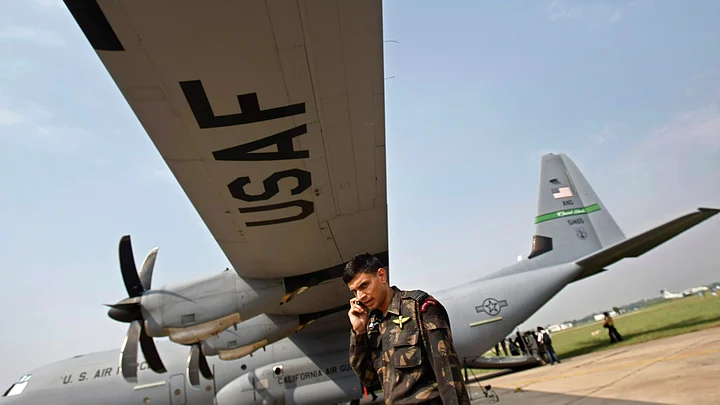For over two decades, India and the US have been discussing several enabling mechanisms to embellish their cooperation between the two armed forces. A report in a leading daily on 21 December, on Defence Minister Manohar Parrikar’s visit to the US, must have raised many eyebrows. Experts may even attribute it to “questionable government policy on a sensitive issue concerning national interest of India.”
This is not a sudden development in our relations with the US. Agreements on Logistics Support (LSA), Communications, Interoperability and Security (CISMOA) and Basic Exchange and Cooperation (BECA) have been on the agenda of the India-US defence dialogue for many years.
Indeed, this had also figured prominently in Parliament, when the then External Affairs Minister Pranab Mukherjee had to clarify that this agreement “does not envisage providing military facilities to US forces. Neither does it provide for unqualified Indian support to the US in any armed conflict to which India is not a party.” Despite such assurances left-wing parties (critical allies) continued to oppose this agreement.
Why Logistics Support Agreement Makes Sense
- Military cooperation is crucial – the Indo-Soviet treaty of 1971 assisted India in the war with
Pakistan.
- Efforts to enhance Indo-US military cooperation received little or no support till liberalisation re-enabled the process.
- Bilateral engagements, such as the March 2006 agreement involving joint patrolling of energy trade routes, have been helpful.
LSA’s Purpose and Content
It is necessary to understand the purpose and content of such agreements in existence with about 80 countries, including Pakistan (expired in 2012 and is under discussion now).
Since LSA is considered to be an important ingredient for joint military exercises and disaster relief operations, some pros and cons of signing this agreement from an Indian perspective may be of value to understand the significance of the debate. But more about that later.
The Soviet Experience
A historic perspective on events leading to high-level engagement with the US military is necessary. From 1965, when military acquisitions from the erstwhile Soviet Union commenced, up to its disintegration, India was a major recipient of military hardware.
Yet, there were no joint exercises or operations between the two militaries. In 1971, an Indo-Soviet treaty of friendship and cooperation was signed. This timely treaty, which assisted India in the war with Pakistan, placed us squarely in the Soviet camp.
India’s Anti-Americanism
That President Richard Nixon disliked Indira Gandhi and then Secretary of State Henry Kissinger was equally hostile to India, have been well documented. In turn it led to a generation of US politicians, military and civil servants, who were hostile to India. During this period, the Pakistani military continued to build on its close relations with Pentagon which began during the CENTO days and flourished during the Soviet invasion of Afghanistan.
Consequently, the Indian military, barring those who attended courses in the US and the UK, were denied the opportunity to be familiar with American operational doctrines and the manner in which Congressmen lobbied for military assistance to friendly countries.
In short, while there was a fair understanding of the Soviet system and training methodologies, little was known of the American system of checks and balances, legislative and executive controls and the White House-Congress interface.
During the same period, in India, anti-American sentiments ran high for numerous reasons. The US patch-up with the Chinese through senior Pakistani politicians and generals and stage-managed by Kissinger, the Vietnam war, USS Enterprise incident in 1971, sanctions against India in 1974 and 1998 and many such actions did not help the deteriorating relationship.
Non-Alignment Doctrine
Distrust of American intentions and manipulations were fuelled by the deep-rooted philosophy of non-alignment and left leaning ideologies both at the political and bureaucratic levels. Consequently, efforts to normalise relations and enhance military-to-military contacts received little or no support at all levels of governance in both countries.
Liberalisation and globalisation began the process of political and military engagement with the US. As expected, every move was carefully weighed both in the context of sovereignty and non-alignment.
The collapse of the Soviet Union not only disrupted regular supply of spares, resulting in low operational readiness of military assets, but more importantly the newly-formed Russia was unable to provide training facilities for warships on order, as the Russian military personnel were neither paid nor compensated by the state. Many Russian officers survived on driving cabs after working hours. India had to diversify her source of supply of military equipment or face the proverbial “all eggs in one basket” analogy.
A New Beginning
India-US military cooperation and dialogue commenced a new phase of operational trend in 1993. By the turn of the century an incremental process was adopted at a slow pace to enable both parties to adjust to a new paradigm shift.
Two examples of successful and mutually beneficial engagement that resulted in quality agreements were the June 2005 India-US new defence framework agreement with a road map for operational, joint military exercises, training and services exchange and the March 2006 India-US maritime cooperation framework.
The former resulted in maximum number of military exercises of a highly advanced level and the latter in joint patrolling of energy trade routes to combat piracy and transnational crimes at sea.
(To be concluded)
(The writer is a former Commander-in-Chief, Southern Naval Command)
(At The Quint, we question everything. Play an active role in shaping our journalism by becoming a member today.)
